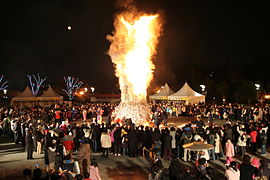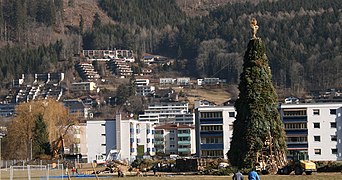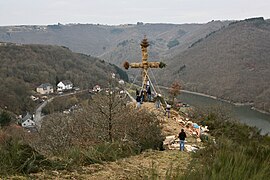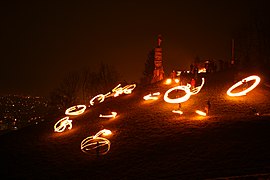Fire customs


Fire customs is a collective term for the burning of fires in customs . These are all major fires.
Overview of usage forms (selection)

- Biikebrennen , North Friesland , Schleswig-Holstein , February 21 , on the eve of the feast day " Petri chair celebration in Antioch " ("Petritag")
- Burgbrennen , on Spark Sunday, first Sunday after Ash Wednesday (Alemannic)
- Dita e Verës , pagan spring festival on March 14th in Albania
- "Carnival fire": see disc fire
- "Fire in the Alps", an action that has been cultivated in the Alps since 1988 in August, visible from afar, as a contribution to the sustainable development of the Alpine region .
- Sparkfire , also on "Funkensonntag"
- Sacred Heart Mountain Fire , 2nd Friday after Corpus Christi , Tyrol
- Halloween (originally maybe Irish Samhain , today increasingly worldwide, also Heischebrauch )
- Hüttenbrennen , Eifel , Germany, on Funkensonntag
- Hutzelfire , regional variant of the winter burning in central , eastern and northern Hesse and in Thuringia with a focus on the Rhön
- Martinsfeuer on the occasion of St. Martin's Day on November 11th, e.g. B. at the end of Martinszügen or on the vineyards of the Ahr valley
- New Year's bonfire (remodeling of the winter solstice bonfire , today replaced worldwide by fireworks or the Christmas tree )
- Easter bonfires and other spring festivals
- Disc fire , also on "Funkensonntag"
- Sechseläuten , mid-April, Zurich , Switzerland
- Solstice or Midsummer bonfire , June 21 to 24, Europe-wide; partly also at the winter solstice
- Walpurgis Night : "Witches Burn" on the night of April 30th to May 1st
In some of these customs, burning a figure is e.g. B. made of straw an integral part of the ritual.
Full Moon Festival ( full moon festival ), Daeboreumnal, Korea , February 2008
Fire pyramid , Bludenz , Austria, February 2008
Straw cross for the “ castle burning ”, Bivels , Luxembourg , March 2009
Logs for a bonfire of Ulster - loyalists in the night before the Orangemen's Day (July 12), Northern Ireland , 2009
Glowing rotating discs on their sticks at the Bürgler Funkenfeuer , Dornbirn , Austria, February 2012
General forms are:
- Fire wheel (Christmas, New Year, Carnival, Easter or Pentecost)
- The custom around the hearth , handed down around the world since ancient times, has largely died out across Europe.
The emergency fire (probably Germanic, survived into the 20th century) or thanksgiving fire ( in Europe, however, naturally linked to an autumn date, see “Potato fire ”) are related to the occasion.
Legal position
Germany
Traditional fires must not endanger environmental concerns or public safety. They are at least notifiable and must be supervised by the organizer.
Austria
So far, open large fires for traditional events could be held largely without any problems, provided that relevant safety and fire protection measures such as the presence of the fire brigade - the volunteer fire brigades are traditionally closely involved in customs - or fire watch even after a fire , as well as sensible handling of the fire materials, provided . With the Federal Clean Air Act introduced in 2002, the previous state air pollution laws were repealed. Since then, the burning of "Fire in the context of traditional events" is - temporal and spatial Exemption by regulation by the Governor provided - only permitted if the fire "exclusively biogenic be loaded materials" This is problematic in that it in some traditions fires such as the Vorarlberger Funkensonntag , which is included in the list of intangible cultural heritage in Austria , and also many other fire customs, in which figures or other things are traditionally burned beyond a pure fire, or freshly felled wood is used for the purpose, is not possible to comply with strict requirements of the law. In this regard, the law was described as "overshooting the goal [of preventing unnecessary air pollution, note]", but from the other side a stricter regulation regarding the well-known problem of Easter waste disposal and the trend towards more and more spectacular fires - including the use of fire accelerators - quite welcomed.
Switzerland
Traditional fires, for example on the occasion of the national holiday on August 1st, are permitted, but the burning of natural forest, field and garden waste is only permitted if it does not result in excessive emissions (Art. 30c USG ) and if it is so dry that there is little smoke arises.
See also
Web links
- Institute for History and European Ethnology , University of Innsbruck , uibk.ac.at: Year, Solstice, Midsummer, Sacred Heart Fire
literature
- Herbert Rauchenecker: Customs of light and fire. Sign of the search for life and the joy of life. Verlag Sankt Michaelsbund , 2003, ISBN 978-3-920821-39-9
- R. Wolfram: The annual fire. In: Österr. Folklore Atlas. Commentary and Maps, 3rd volume, 1968, p. 52, and 4th volume, 1971, p. 68,69.
Individual evidence
- ↑ Information on the holiday of February 22nd , accessed on August 11, 2010
- ↑ Reinhard Cremer: Hope for tradition . badische-zeitung.de , Efringen-Kirchen , February 23, 2010; accessed March 12, 2017
- ↑ feuerindenalpen.com feuerindenalpen.com
- ↑ Tyrolean mountains in flames - the 10 most spectacular mountain fires . tirol.at, March 4, 2017 ( 9 Sacred Heart Fire in the Tannheimer Tal )
- ↑ Martinsfeuer and Martingsumzuges. Retrieved November 4, 2019 .
- ↑ Make the longest night of the year appear shorter. In: Stimme.de. Retrieved December 10, 2017 . Gemmingen
- ↑ about Roman Häußl: About burning and traditional fire . In: Lower Austrian community newspaper . May 2005 ( Webrepro , ris.at [accessed on October 6, 2010] Legal situation before 2010 amendment).
- ↑ Federal Air Pollution Control Act 2002 as amended in Federal Law Gazette I No. 77/2010
- ↑ cf. § 10
- ↑ § 3 line 4
- ↑ § 1a Definitions Z. 4
- ^ Quote from ÖVP national culture spokesperson LAbg. Walli Ebner, quoted in n. Solstice fire exception . In: Salzburger Nachrichten . October 6, 2010, local section Salzburg Aktuell , p. 6 ( article archive ). , cf. also “shot at sparrows with cannons” . In: Salzburger Nachrichten . ( Article archive ). "Insane ban on traditional fires" . In: Salzburger Nachrichten . September 30, 2010 ( article archive ).
- ↑ Peter Gspaltl, Christoph Sudy: Customs or Waste Disposal? Project work for the service examination for the higher technical service. April 2000 ( feinstaubfrei.at [PDF]).
- ↑ cf. also material collection on Easter bonfire - focus: air pollution in the Graz area. (No longer available online.) ALS citizens' initiative, July 16, 2009, archived from the original on October 23, 2009 ; Retrieved October 6, 2010 .
- ↑ Regula Rometsch, Angelo Papis: Air hygiene measures plan prohibits waste incineration outdoors: no fires outdoors in winter (PDF) Zürcher Umweltpraxis 2010, p. 7 f.
- ↑ Art. 26b of the Clean Air Ordinance (LRV) of December 16, 1985






